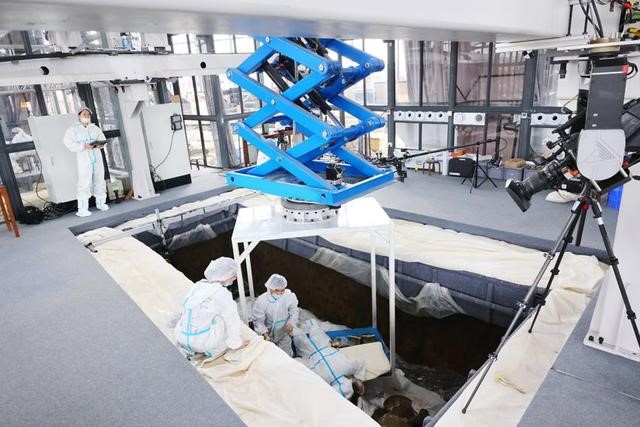China's archaeology becomes more and more "tech-ish"
Shovels, brushes and tape measures are probably what one could think of when it comes to the tools of archaeologists. However, it's not a difficult thing to see modern technologies being applied in China's archaeological tasks nowadays.

Photo shows an on-site archaeological workshop established at the excavation site of Sanxingdui, southwest China's Sichuan province. (Photo courtesy of the Sichuan Provincial Cultural Relics and Archaeology Research Institute)
At the site of archaeological excavation for Wanjiao One, an ancient Chinese merchant ship that sank off the coast of Pingtan county, southeast China's Fujian province, archaeologists were equipped with full-face rebreathers that put them on wireless communication with their colleagues both under and above the water.
In the aquarium that houses the Nanhai No. 1 shipwreck, discovered 25 meters under the South China Sea in 1987 and salvaged 20 years later, remote sensing platforms can obtain data at millimeter level in a contactless, multi-angle and smart manner.
Besides, at the Sanxingdui archaeological site in southwest China's Sichuan province, on-site workshops have been built to better preserve cultural relics.
The application of modern technologies has enriched the philosophy, methods and content of archaeology. It is also making archaeological missions safer, more precise, and more effective, broadening and deepening China's archaeology cause to an unprecedented extent.

Visitors watch a model of an archaeological park with a holographic projector at an archaeological site in Shangpan, Pingtan Comprehensive Experimental Zone, southeast China's Fujian province, July 19, 2021. (People's Daily Online/Xie Guiming)
The excavations of Sanxingdui have been carried out under the support of multiple disciplines, which mirrors the integration of modern technologies and archaeology. At the excavation site, there are many transparent glass houses that are designed to protect unearthed cultural relics. The temperature and humidity in these houses are fixed, and trusses and lifters are there to move the relics and for archaeologists to clean the relics in a contactless manner.
China's modern archaeology raised its curtain as relics were unearthed in the excavation of the Yangshao site in Chisheng county, central China's Henan province a hundred years ago.
Today, remote sensing, as well as digital and smart technologies are widely applied in archaeological investigations, and new methods are being promoted one after another, such as 3D printing, aerial photography drones and DNA analysis. Be it under the earth or in the water, technologies are playing an increasingly important role in archaeological surveying, excavation, restoration, preservation, and researches.
To trace the origins of cultural relics and civilizations and represent the glorious history is a special mission of archaeology. Today, with radiocarbon dating, we know ages of cultural relics, and with lead isotope geochemistry, we know origins of them. The broad and in-depth sci-tech application is enlarging the space of archaeological studies.

Visitors watch a 3D-printed replica of the Cave 57 of the Mogao Grottoes - a renowned site containing Buddhist art in Dunhuang, Gansu province - in the Zhejiang University Museum of Art and Archaeology in Hangzhou, Zhejiang province, Nov 2, 2021. (People's Daily Online/Long Wei)
Cultural relics are history in a perceptible form. To enhance people's understanding of history and their respect for civilizations with cultural relics is an important part of the preservation and inheritance of cultural relics.
For instance, the launch of the Digital Dunhuang resource database enables people around the world to enjoy the magnificent views of the Dunhuang Mogao Grottoes with just clicks on their mouse, and a mini-program introducing the cultural heritage has so far received nearly 40 million visits.
Besides, in Fuzhou Museum, Fujian province, a motion sensing system is launched to simulate an underwater archaeological site, so that visitors can have better experiences.
Digital technologies are constantly changing the ways of how cultural relics are displayed, making people's cultural life more splendid and offering a strong support for the protection of cultural relics.
Photos
Related Stories
- 99,000-yr-old bone tool believed to be oldest in China
- Archaeologists unearth ancient urn burial tombs for children in north China
- Tombs discovered in east China possibly royal ones: experts
- University archaeological classes move to on-site location at ancient historical site in N China
- 29 ancient tombs unearthed in China's Shandong
- China lists top 100 archaeology findings of past century
Copyright © 2021 People's Daily Online. All Rights Reserved.










